Basic Principles of Classical Ballet (18 page)
Read Basic Principles of Classical Ballet Online
Authors: Agrippina Vaganova

75. Pas de basque
Pas de basque backward is done the same way. 5th position, right foot front, demi-plié, left foot glides back, describing a half-circle en dedans, jump on left foot; right foot glides through 1st position backward in croisé demi-plié, and on
three
—the feet join with the same gliding jump, only backward. The arms move the same way.
GRAND PAS DE BASQUE
To lend the jump more force, this pas is done with arms thrown up. At the beginning throw the arms into 2nd position, and carrying them through the preparatory and 1st positions, lift them into 3rd. The feet do all movements in big positions. The right foot describes a big half-circle en dehors at 90°, the left leg in demi-plié; carrying the right foot to 2nd position, do a big jump onto the right foot (arms in 3rd position), the left leg is bent and thrown out forward at 90°, the arms are gradually opened into 2nd position. The left foot is lowered to the floor forward in croisé, and both feet are pulled into the final pose, as in the small pas de basque. To give this pas a final polish, bend the head and body forward at the beginning of the movement, and lift them at the moment when the arms are thrown out into 3rd position.
To do the movement backward, describe a circle with the left foot en dedans, carrying the leg into 2nd position at 90°, jump on left foot, right foot is bent high and moves, opening backward. Fall on right foot back in croisé. The end of the movement and the arms are the same as in the pas forward.
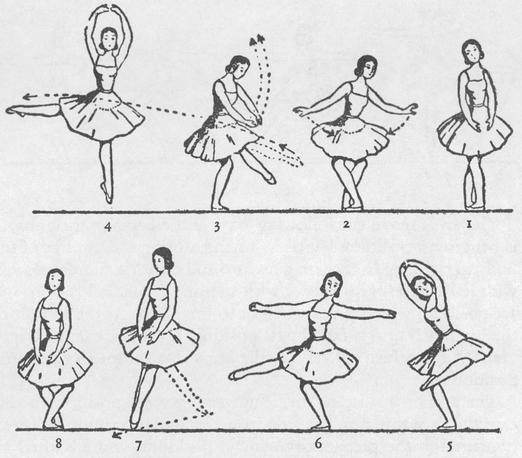
76. Grand pas de basque
SAUT DE BASQUE
Stand in 5th position, right foot front. Do a coupé with right foot without a jump, lifting it to the knee, and simultaneously press left heel to the floor in demi-plié. Move right foot, extending it into 2nd position with a passing movement, following that make a half turn on it to the right, thrusting left leg into 2nd position at 90°, towards point 2. Complete the turn with a jump, travelling to the side in the direction of thrust-out left leg, so as not to remain on the same spot during the jump, fall on left foot in demi-plié, while right leg bends to the knee. This bending is done right after the foot leaves the floor and without any additional movements with the leg, as is often observed when the step is executed incorrectly. Both legs in this pas should be fully turned out, especially the right one as its knee is forcefully turned to the side.
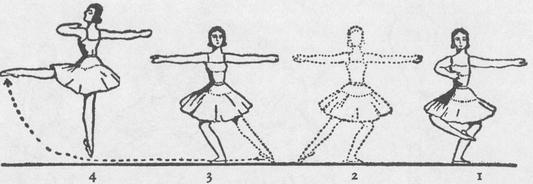
77. Saut de basque
The arms move the following way: at the beginning right arm is bent in 1st position, left one—in 2nd; during the transfer of the body to right leg, right arm goes into 2nd position simultaneously with left leg, left arm moves with a strong thrust below through 1st position, which gives strength to the jump. At the instant of the jump, left arm is bent in 1st position, right one extended into 2nd. At the return to left leg, the arms also return to the initial position.
The arms may also be thrust upward into 3rd position; in this case they are thrust to the side from the initial position half-way up, through the preparatory and 1st positions, and are lifted all the way up during the jump, so as to give oneself a good lift.
In this manner, as the jump is repeated several times, the arms do not return to the initial position but are extended to the side, and from there, through the preparatory position, they are swung for the succeeding jump.
23
GARGOUILLADE
This old French term has remained in the Italian school. In the Russian school we call this step rond de jambe double.
Stand in 5th position, right foot front. At the initial demi-plié right leg does rond de jambe en l’air en dehors; when this movement is finished and the leg is open in 2nd position, transfer with a jump to right leg in demi-plié. Simultaneously left leg does rond de jambe en l’air en dehors, but begins and ends it at the calf of right leg; after this left leg moves forward on the floor into croisé in demi-plié.
As this movement is usually a passing one, the arm movement is governed by the preceding and succeeding poses.
This step en dedans is seldom done on the stage, but is used in class. It is done in the following manner: stand in 5th position, right foot front, begin with left leg rond de jambe en l’air en dedans and, transferring on to it with a jump in demi-plié, do rond de jambe en dedans beginning and ending it at the calf and move the leg backwards, following the instructions given for en dehors.
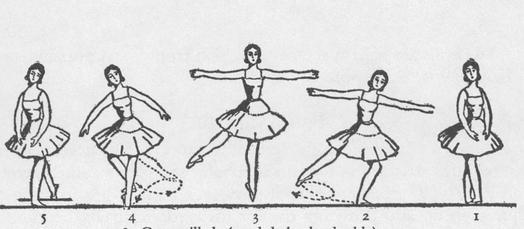
78. Gargouillade (rond de jambe double)
PAS DE CISEAUX
Stand in croisé back, right foot back; plié on left leg, and with a short and strong grand battement, thrust right leg forward in effacé to 90°, throwing the body back. Left leg joins right one in the air, and immediately, extended, moves back on the floor through 1st position into 1st arabesque, while right one is lowered to the floor in plié. The characteristic moment here is when both legs are in the air. This change of legs is done in one count.
This form of pas de ciseaux is used for study; for the stage dance there exists another approach which is more effective. When, after the execution of a given step, you stop in a pose with left leg in croisé forward lifted to 90°, you should do a coupé on it, thrusting right leg, etc. The body is fully involved in this movement. It is forcefully bent back during the passing of one leg by the other in the air, and is later thrust forward into arabesque.
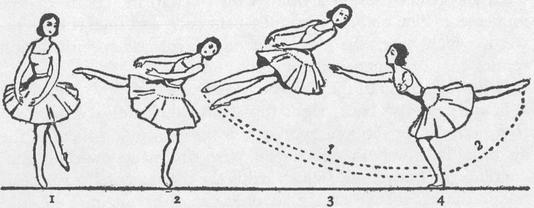
79. Pas de ciseaux
The arms are held at the beginning in front in 1st position, and then they take the pose of arabesque.
PAS BALLOTTÉ
This is a very difficult movement to execute in its correct form. It requires strength in the legs and body and girls seldom succeed in it. Usually, they simplify it very much and bring it down to jumping up and thrusting the leg forward and back, bending it so much, in addition, that ballotté loses entirely its original form.
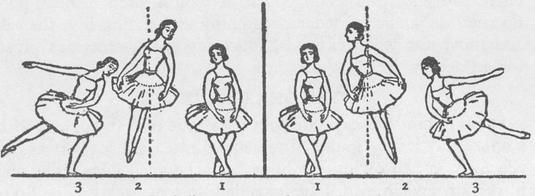
80. Pas ballotté: 3, 2, 1—front; 1, 2, 3—back
The term ballotté is very picturesque; it evokes the vision of a boat rocking on waves, and a well-executed ballotté does resemble such rocking. No stop, no pause, is noticed in the movement. The dancer sw ngs in the air, with her legs closed and extended, forward and back, passing a point which lies in the centre of this movement. The body is forcefully bent back and then thrust forward, which, when the legs are extended, forms a specific design reminiscent of nonchalant rocking.
Ballotté is done in the following manner:
Stand in croisé back, right foot forward. Demi-plié on right foot, join the legs in a jump in 5th position, moving them in the air past the point on which you were originally standing and, bending the body back (which helps the movement a great deal) fall on the left foot in demi-plié, open the right one in effacé, and without bending it, push off, again joining the legs in 5th position, move them past the point on which you were originally standing and bend the body forward. Fall on the right foot in demi-plié, left leg in effacé back at the necessary height.
The legs should be as much extended as possible, the body and the legs should form one unit. Then we succeed in getting the soft, wave-like rocking. The arms are balanced with the legs. At the stop in the forward movement, the left arm is bent into 1st position, the right one extended to the side in 2nd position; at the stop on the right foot, the right arm is in 1st position, the left one in 2nd position. The change of arms is done softly, and they pass their original positions.
It is more convenient to begin to study ballotté from 5th position; do demi-plié, joining the legs into 5th position during the jump, press the soles firmly together, with the toes extended, at the beginning of the jump, and in this manner fly forward from the spot on which you were standing at the beginning, fall on left foot in demi-plié, right leg open in effacé forward at 45°.
Conclude by doing assemblé. In the same manner ballotté is also done backwards, i.e. after the jump from 5th position fly back with both feet from the spot you were standing at the beginning, fall on right foot in plié in effacé at 45° and conclude with assemblé.
PAS BALLONNÉ
Stand in 5th position, right foot front, demi-plié; gliding the right foot into 2nd position at 45°, push off the floor with the left foot, toes extended, and fly over, as it were, towards the toe of the right foot, lowering yourself on the left foot in demi-plié, at the same time bending the right one sur le cou-de-pied.
Often, when teaching children, teachers do not pay attention to the correct placing of the foot sur le cou-de-pied. The foot is carried past the other leg, the legs cross, and the resulting pose is both incorrect and bad looking.
Ballonné is done in all directions: efface, croisé forward and back, écarté forward and back. The arms should be placed according to the direction of the movement. For instance, when you do ballonné en effacé with the right foot, the left arm may be bent in 1st position and the right one extended to the side. But if you change the body the least bit, turning the right shoulder forward, you get a jump in écarté. In this case it is better to bend the right arm and to extend the left one, bending the body slightly back and left, as it is required by the pose. One may also lift one or both arms up, in 3rd position.
